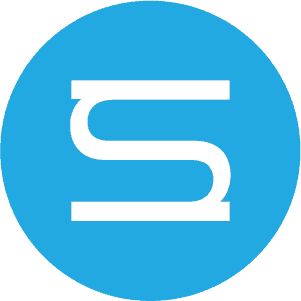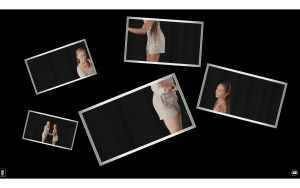As a concept, making Dance For Screens seemed completely doable: make some choreography, capture it on film, edit that footage into a series of short screendances and then implement those screendances on a couple of cell phones for an interactive installation. Simple, right?
Not quite.
Each aspect of this project came loaded with a its own set of learning curves and tiny hurdles to overcome. And, despite the frustrations I met along the way (or perhaps because of them) I feel absolutely satisfied with what I’ve made. So… what did I end up making?
What resulted at the end of the summer was an interactive dance installation not for 5 cell phone screens, but one giant screen. I’ve been testing it touchscreen display that lives just north of the Studio doors. The videos I shot and edited (and re-edited [and re-edited again {and again}]) that were originally meant to be displayed on a loop on a couple of phones are now movable across a 4K display. There are now 7 distinct scenes that can be displayed at will inside the resizable frames. I even developed a button that will shuffle and rotate the frames randomly on the screen surface. And, perhaps the thing that most excites and frustrates me about the interface (because I can’t seem to get it to work as seamlessly as I would like) is the ability for whomever interacts with the installation to take a screencapture of the display and email it to themselves.
An interesting thing happened toward the end of the process. I began to understand to more clearly the purpose of my project. It’s a way to dance the archive. Most often dances are received passively by their audiences. A choreography is made, rehearsed, and packaged up with costumes, lights and music for an audience that sits and receives it in a theater. Or if it’s received as a screendance, it’s been captured on film, edited for the screen and distributed (more often than not) digitally to some sort of device. Either way, much of the labor that went into making and packaging the dance is invisible to the audience. I realized that what I was revealing with Dance For Screens was a way to make some of that labor less invisible.
While the process of getting from nothing to something seemed like an arduous trek while I was in the thick of it (mostly because I was really charting my own path and developing my own workflows), in retrospect those hills I climbed weren’t insurmountable as I thought. Making choreography is nothing new to me — but making choreography that is meant to be filmed and displayed on 2D surfaces? I had to check that one off the list. Not only that, I had to be my own cinematographer and camera crew. The came the editing (and generous re-editing). I challenged and tested my skills using Adobe Premiere Pro and After Effects. Check that off the list too. And finally implementation. While I intended for this installation to be experienced on cell phone screens, thanks to Hannah and Ethan (part of the genius crew at the Studio), I was able to test the videos on the touchscreen and instantly fell in love with the interface. The only problem there was I had never used the Intuiface software that creates and manages the content on the touchscreen. So I had to learn that software as well, crash-course style. And while each of these softwares and methods was exciting and challenging to learn in order to produce Dance For Screens, ultimately what was most valuable was learning how to develop efficient and useful workflows — I’m grateful that I had the time and space to do precisely that.
-Marc Macaranas

